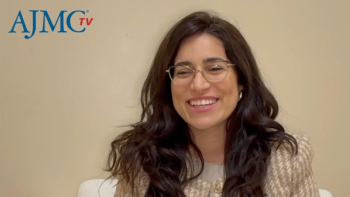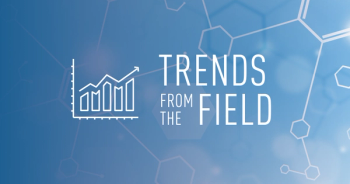
The American Journal of Managed Care
- November 2023
- Volume 29
- Issue 11
Rituximab Reference vs Biosimilar Utilization for Oncology vs Nononcology Indications
Reporting on the real-world utilization of reference rituximab and its biosimilars can help show prescribing habits and reveal cost-saving opportunities.
ABSTRACT
Objectives: Limited data exist on the adoption of rituximab biosimilars vs the reference product by indication. Available data from real-world studies comparing rituximab biosimilar and reference use have focused predominantly on oncology indications. This is the first study to assess the utilization of the 3 US rituximab biosimilars vs the reference product.
Study Design: Comparative analysis.
Methods: Deidentified real-world data of rituximab, rituximab-abbs, rituximab-pvvr, and rituximab-arrx dispensations between December 31, 2018, and February 1, 2022, were extracted using Trisus Medication Compare (The Craneware Group). The primary outcome was rituximab reference vs biosimilar utilization for oncology vs nononcology indications. Results were stratified by on-label and off-label use and treatment settings.
Results: A total of 28,025 encounters were captured for rituximab and its biosimilars across 193 facilities (rituximab: n = 23,395; biosimilars, n = 4631 [rituximab-abbs: n = 2550; rituximab-pvvr, n = 2081; rituximab-arrx: n = 0]). Rituximab reference had higher dispensations for oncology (78.4%) and nononcology (88.3%) indications than its biosimilars (21.6% and 11.7%, respectively; P < .01). The 3-year annual trends from 2019 to 2021 revealed decreased rituximab reference utilization (99.99% to 40.1%) and increased biosimilar use (0.01% to 59.9%). Most oncology dispensations were on label (94.5%), whereas most nononcology dispensations were off label (73.6%; P < .01). A higher proportion of biosimilar use was attributed to on-label indications (67.7%; off-label, 32.2%) compared with rituximab reference (58.0% vs42.0%, respectively; P < .01). Nonacademic settings showed higher biosimilar adoption than academic settings (22.2% vs 10.3%, respectively; P < .01).
Conclusions: Real-world evidence shows an increase in rituximab biosimilar adoption over time, with higher adoption for oncology vs nononcology indications and in nonacademic settings.
Am J Manag Care. 2023;29(11):e353-e356.
Takeaway Points
- Data are limited on the comparative utilization of reference rituximab and its biosimilars for oncology and nononcology indications.
- Results from this real-world analysis show increasing rituximab biosimilar adoption, with lower adoption rates for nononcology indications and academic settings.
- These utilization trends provide insight into the dynamic prescribing habits of physicians.
- Additional studies are warranted to uncover potential barriers to biosimilar uptake.
Rituximab (Rituxan) is one of a few FDA-approved drugs with available biosimilars used in the management of both oncology and nononcology indications. Increasing use of biosimilars promotes cost-effective patient care and improves patient access to treatment options.1 Physicians are gaining confidence in prescribing biosimilars and play a key role in influencing their acceptance.1 Disseminating trends in rituximab reference and biosimilar utilization by indication can provide insight into the real-world prescribing habits of physicians, quantify projected cost savings, and reveal the existence of lingering barriers to biosimilar implementation.
Currently, rituximab has 3 biosimilars available on the US market: rituximab-abbs (Truxima; approved November 2018), rituximab-pvvr (Ruxience; approved July 2019), and rituximab-arrx (Riabni; approved December 2020). Limited data exist on the adoption of rituximab biosimilars vs the reference product by indication2; of the real-world data available, analyses are primarily conducted for oncology indications.3,4
Rituximab and its biosimilars are used for multiple on- and off-label indications in both oncology (eg, chronic lymphocytic leukemia, follicular lymphoma, Burkitt lymphoma) and nononcology (eg, microscopic polyangiitis, rheumatoid arthritis, multiple sclerosis) therapeutic areas. The purpose of this research was to capture the real-world trends in the utilization of rituximab reference vs biosimilar products by both oncology and nononcology indications, by on-label and off-label use, and by treatment setting.
METHODS
We performed a retrospective observational study using national deidentified real-world data captured between December 31, 2018, and February 1, 2022, using Trisus Medication Compare (The Craneware Group). Dispensations of the rituximab reference product were compared with rituximab biosimilar products, rituximab-abbs, rituximab-pvvr, and rituximab-arrx, and were inclusive of all payer types. Baseline demographics collected include age, gender, site of care, and treatment setting (urban or rural; academic or nonacademic center). The primary outcome was the utilization of rituximab reference vs biosimilar products for oncology vs nononcology indications. Indications were determined by the International Statistical Classification of Diseases, Tenth Revision (ICD-10) diagnosis codes (see eAppendix Table for complete list [
Descriptive statistics and graphs were used to report yearly and quarterly usage trends by indication and on- vs off-label use. Analysis of variance and χ2 tests were used to identify factors significantly associated with rituximab reference and biosimilar usage. All tests for statistical significance were 2-tailed with an α < .05. Analyses were performed using R version 4.1.1 (R Foundation). The Long Island University Institutional Review Board determined this study to be exempt.
RESULTS
Overall, 28,025 encounters were captured for rituximab and its biosimilars across 193 facilities (rituximab reference: n = 23,395 [83.5%]; biosimilars: n = 4631 [16.5%] [rituximab-abbs; n = 2550; rituximab-pvvr, n = 2081; rituximab-arrx, n = 0]). Male patients comprised 46.4% of the study population. The mean age was 60.3 years for patients receiving rituximab reference and 62.9 years for those on biosimilars (P < .01). The study population was primarily from urban centers (97.1%; rural, 2.9%) with an outpatient site of care (85.7%; inpatient, 14.3%) and evenly split between academic and nonacademic settings (47.6% vs 52.4%, respectively).
Overall, Annual, and Quarterly Utilization Trends
Overall, there was a higher number of dispensations of rituximab reference for both oncology (n = 10,713 [78.4%]) and nononcology indications (n = 12,682 [88.3%]) than its biosimilars (oncology: n = 2950 [21.6%]; nononcology: n = 1680 [11.7%]; P < .01) over the total study period. The 3-year annual trends from 2019 to 2021 of overall use revealed decreased rituximab reference utilization (2019: 99.99%; 2020: 88.2%; 2021: 40.1%) and increased biosimilar use (0.01%, 11.8%, and 59.9%, respectively). Quarterly trends from 2019 to 2021 by reference vs biosimilar utilization for the overall population (
Use of Reference vs Biosimilar Product by Labeled Indication
A higher proportion of biosimilar use was attributed to on-label indications (67.7%; off-label, 32.2%) compared with rituximab reference (58.0% vs 42.0%, respectively; P < .01). Most oncology dispensations of rituximab reference were for on-label uses (n = 12,907 [94.5%]), whereas most nononcology dispensations were for off-label indications (n = 10,575 [73.6%]; P < .01). The 3-year annual trends from 2019 to 2021 of use for on-label indications were consistent with the overall trend of decreased rituximab reference utilization (2019: 99.99%; 2020: 85.7%; 2021: 34.9%) and increased biosimilar use (0.01%, 14.3%, and 65.1%, respectively). The same trend was noted for off-label use (reference product: 100%, 91.8%, and 48.4%; biosimilar products: 0%, 8.2%, and 51.6%).
Use of Reference vs Biosimilar Product by Treatment Setting
Dispensations of rituximab reference and its biosimilars were higher in urban vs rural treatment settings (rituximab reference: 96.8% vs 3.2%; biosimilars: 98.5% vs 1.5%; P < .01) and in outpatient vs inpatient sites of care (rituximab reference: 86% vs 14%; biosimilars: 83.8% vs 16.2%; P < .01). By percentage of dispensations within the study period, nonacademic settings showed higher biosimilar adoption (22.2%) than academic settings (10.3%; P < .01).
DISCUSSION
This is the first study to assess the utilization of the 3 US rituximab biosimilars compared with the reference product. The 3-year annual trends from 2019 to 2021 for overall use revealed decreased rituximab reference utilization by more than half and increased biosimilar use to approximately 60%. This finding was consistent with previous data reported by Otremba et al, which evaluated the real-world use of various rituximab biosimilars used in oncology practices in Germany and reported a decrease in rituximab reference product prescriptions (51.5% to 15.6%) and an increase in biosimilar prescriptions (12% to 83%) between 2017 and 2019.4 Such analyses provide insight into the real-world uptake of these lower-cost agents and reveal changes in physician prescribing habits for biosimilars and the specific indications for which these products are prescribed.
The results of our study indicated a predominant use of rituximab reference on label (58%) compared with off label (42%). Product utilization by therapeutic area revealed that most oncology dispensations were for on-label uses (94.5%) and most nononcology dispensations were for off-label indications (73.6%). Both of these findings are consistent with real-world data from a Canadian hospital that indicated greater on-label use of rituximab reference (59.8%) compared with off-label use (40.2%).2 Oncology made up 58.6% of the on-label use, followed by the nononcology indications granulomatosis with polyangiitis (1.0%) and rheumatoid arthritis (0.2%). Off-label use reflected more nononcology indications (oncology [22.1%], hematology [6.4%], immunology [1.7%], infectious diseases [1.0%], nephrology [6.9%], neurology [1.9%], rheumatology [0.2%]).2 The diverse on- and off-label indications for rituximab biosimilar use observed within this study reflect the benefits of the abbreviated 351(k) approval pathway for biosimilar products: improving access and treatment options at a potentially lower cost.5
Trends in biosimilar utilization and diverse indications reported within this study may reflect significant cost savings to health care stakeholders. A US budget impact analysis of rituximab reference vs rituximab-abbs estimated an annual savings of more than $310,000 for a 1 million–member US payer following a 4.5% utilization shift from the reference product to the biosimilar. Trends on incremental savings for patients with non-Hodgkin lymphoma were shown to be higher compared with other indications, including chronic lymphocytic leukemia, rheumatoid arthritis, granulomatosis with polyangiitis, and microscopic polyangiitis.6 Boidart and colleagues’ 2020 study also simulated the replacement of rituximab by a rituximab biosimilar for all its indications, whether on or off label.2 Assuming a 10% price reduction for the switch to a biosimilar, the simulation estimated an annual cost savings of more than $386,000.2 Biosimilars offer significant cost savings to patients and health care systems compared with their biologic product; these lower costs may translate to increased patient access.7 Use of lower-cost biosimilars has provided more than $12.6 billion in savings since 2011; over the next 5 years, biosimilars are projected to yield $133 billion in savings.8 The high cost of biologics remains a significant barrier to patient access and adherence; in contrast, these lower-price biosimilars can reduce overall health care costs and could improve patients’ medication adherence through increased access, resulting in better health outcomes.9
Barriers to rituximab biosimilar uptake may involve lag time between FDA approval and formulary addition,10 complex and dynamic reimbursement models,11 limited patient knowledge and acceptance of biosimilars,12 and lack of education on biosimilars for health care providers.12,13 Recent reviews from 2 academic medical centers estimate that 6 to 12 months are needed for electronic medical record preparation ahead of formulary review,14 as well as an additional 6 months between formulary approval and institutional implementation of a biosimilar.15 Changes to improve biosimilar utilization are underway and involve increasing provider reimbursement while reducing cost sharing to patients,16 in addition to advancing biosimilar education and familiarity for patients and providers.17 Continuing to highlight trends in utilization can reveal patient and provider acceptance, show projected cost savings, and indicate the existence of lingering barriers to uptake.11
Strengths and Limitations
The strengths of this analysis include the use of real-world data, a large sample size compared with similar studies, a direct comparison between oncology and nononcology indications, and longitudinal trends in product use across 193 entities. There are also a few limitations to our analysis. We were unable to assess the presence or absence of prior authorization policies or evaluate the underlying incentives for the choice of product used. Additionally, a decrease in the use of these products can be seen around 2021, which may be attributed to the COVID-19 pandemic (eg, supply shortages, budget concerns, patient inaccessibility to health care providers).18 Furthermore, although the data were derived from a large real-world sample, it is important to note that data were obtained from 340B-eligible entities or health systems. We identified indications through the use of ICD-10 coding, which is dependent on the accuracy of the coding process at each entity.
CONCLUSIONS
This real-world data analysis shows increasing rituximab biosimilar adoption, with lower adoption for nononcology indications and in academic settings. Insight into trends and potential cost savings of biosimilar use is valuable for health systems and informs cost-effective decision-making, providing benefits to their institutions, patients, and other stakeholders. Continued large-scale observational studies on the adoption trends of these products are warranted to reveal changes to physician prescribing habits, cost savings, opportunities to improve biosimilar access, and the existence of lingering barriers to biosimilar uptake.
Author Affiliations: The Craneware Group (BAL, RAE, MW, SGJ, RLA), Deerfield Beach, FL; Long Island University Pharmacy (BAL, RAE, MW, SGJ, RLA), Brooklyn, NY; now with MJH Life Sciences® (BAL), Cranbury, NJ.
Source of Funding: None.
Author Disclosures: Dr Labdi, Dr Johnson, and Dr Attridge report employment by The Craneware Group. At the time of publication, Dr Labdi is an employee of MJH Life Sciences, parent company of AJMC’s publisher. Dr Winkler reports former employment by The Craneware Group.
Authorship Information: Concept and design (BAL, RAE, SGJ, RLA); acquisition of data (BAL, MW); analysis and interpretation of data (BAL, RAE, MW, SGJ, RLA); drafting of the manuscript (BAL, RAE, RLA); critical revision of the manuscript for important intellectual content (BAL, RAE, SGJ, RLA); statistical analysis (MW); administrative, technical, or logistic support (BAL, SGJ, RLA); and supervision (BAL, SGJ, RLA).
Address Correspondence to: Bonnie A. Labdi, PharmD, BCOP, MJH Life Sciences, 2 Clarke Dr, Ste 100, Cranbury, NJ 08512. Email: BLabdi@mjhlifesciences.com.
REFERENCES
1. Cuellar S, McBride A, Medina P. Pharmacist perspectives and considerations for implementation of therapeutic oncology biosimilars in practice. Am J Health Syst Pharm. 2019;76(21):1725-1738. doi:10.1093/ajhp/zxz190
2. Boidart A, Darveau M, Déry N, Racine MC. Real-world budget impact of listing a biosimilar of rituximab. Can J Hosp Pharm. 2020;73(1):13-18.
3. Shelbaya A, Kelton JM, Thompson J, Alvir JM, Maculaitis MC, Yang J. Real-world use and acceptance of biosimilar monoclonal antibodies of rituximab in oncology practice in the USA. Future Oncol. 2021;17(30):3941-3950. doi:10.2217/fon-2021-0618
4. Otremba B, Borchardt J, Kuske A, Hollnagel-Schmitz M, Losch FO. Real-world use and acceptance of rituximab biosimilars in non-Hodgkin lymphoma in an oncologist network in Germany. Future Oncol. 2020;16(15):1001-1012. doi:10.2217/fon-2020-0180
5. Review and approval. FDA. Updated December 13, 2022. Accessed December 21, 2022. https://www.fda.gov/drugs/biosimilars/review-and-approval
6. James E, Trautman H, McBride A, Choudhry A, Thompson S. U.S. budget impact analysis of biosimilar versus originator intravenous rituximab for the treatment of non-Hodgkin lymphoma (NHL), chronic lymphocytic leukemia (CLL), rheumatoid arthritis (RA), granulomatosis with polyangiitis (GPA) and microscopic polyangiitis (MPA). J Clin Oncol. 2021;39(suppl 15):e18820. doi:10.1200/JCO.2021.39.15_suppl.e18820
7. Kvien TK, Patel K, Strand V. The cost savings of biosimilars can help increase patient access and lift the financial burden of health care systems. Semin Arthritis Rheum. 2022;52:151939. doi:10.1016/j.semarthrit.2021.11.009
8. The U.S. generic & biosimilar medicines savings report. Association for Accessible Medicines. October 2021. Accessed December 21, 2022. https://accessiblemeds.org/sites/default/files/2021-10/AAM-2021-US-Generic-Biosimilar-Medicines-Savings-Report-web.pdf
9. Zhai MZ, Sarpatwari A, Kesselheim AS. Why are biosimilars not living up to their promise in the US? AMA J Ethics. 2019;21(8):E668-E678. doi:10.1001/amajethics.2019.668
10. May M, Glode AE. Key considerations for biosimilar formulary adoption. Pharmacy Purchasing & Products. 2021;18(5):16. Accessed February 28, 2023. https://www.pppmag.com/article/2744
11. Nabhan C, Valley A, Feinberg BA. Barriers to oncology biosimilars uptake in the United States. Oncologist. 2018;23(11):1261-1265. doi:10.1634/theoncologist.2018-0066
12. Arad N, Lopez MH, Ray R, et al. Realizing the benefits of biosimilars: what the U.S. can learn from Europe. Margolis Center for Health Policy - Duke University. Updated April 28, 2021. Accessed December 21, 2022.
https://healthpolicy.duke.edu/sites/default/files/2021-04/Realizing%20the%20Benefits%20of%20Biosimilars.pdf
13. Oskouei ST, Kusmierczyk AR. Biosimilar uptake: the importance of healthcare provider education. Pharmaceut Med. 2021;35(4):215-224. doi:10.1007/s40290-021-00396-7
14. Kar I, Kronz M, Kolychev E, et al. Biosimilar strategic implementation at a large health system. Am J Health Syst Pharm. 2022;79(4):268-275. doi:10.1093/ajhp/zxab410
15. Lam SW, Amoline K, Marcum C, Leonard M. Healthcare system conversion to a biosimilar: trials and tribulations. Am J Health Syst Pharm. 2021;78(23):2159-2163. doi:10.1093/ajhp/zxab279
16. Edgar BS, Cheifetz AS, Helfgott SM, et al. Overcoming barriers to biosimilar adoption: real-world perspectives from a national payer and provider initiative. J Manag Care Spec Pharm. 2021;27(8):1129-1135. doi:10.18553/jmcp.2021.27.8.1129
17. Mattina C. Overcoming the unique hurdles to biosimilar uptake in oncology. AJMC. April 23, 2021. Accessed November 18, 2022. https://www.ajmc.com/view/overcoming-the-unique-hurdles-to-biosimilar-uptake-in-oncology
18. Corridon C, Kniaz S, Gatziolis W, Shahinian R, Sangwan S. COVID-19’s multifaceted effect on biosimilars. The Center for Biosimilars. April 2, 2020. Accessed February 28, 2023. https://www.centerforbiosimilars.com/view/covid19s-multifaceted-effect-on-biosimilars
Articles in this issue
Newsletter
Stay ahead of policy, cost, and value—subscribe to AJMC for expert insights at the intersection of clinical care and health economics.













































